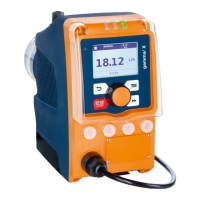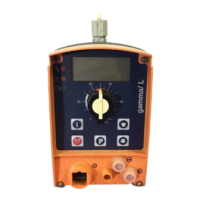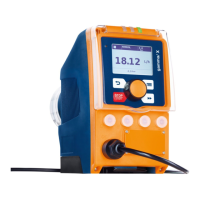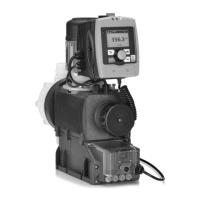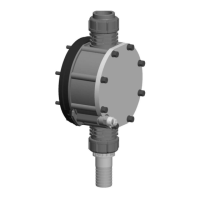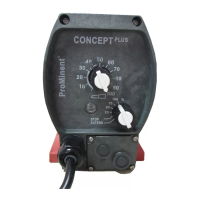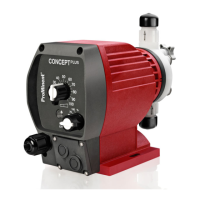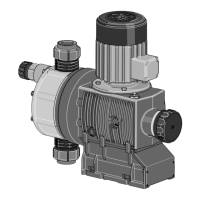11.2.8.4 mA output
‘Menu / Information
è
Settings
è
Inputs/outputs
è
mA-Output
è
...’
You can enter here which signal is to be output similar to the pump
capacity and as an mA signal and how the pump is to respond.
The following can be selected one after the other - Table display:
1.
‘mA-Output’
2.
‘Select the
analogue
signal’
3.
‘Capacity at
20 mA’
4.
‘Behaviour,
mA output’
5.
‘Behaviour
23 mA’
6.
‘Behaviour
3.6 mA ’
‘0...20 mA’
‘4...20 mA’
‘Strokes / hour’
-
‘No change’
- -
‘Behaviour, mA
output’
‘Passive’
‘Error’
‘Warning’
‘Warning +
error ’
‘Warning +
error + stop’
‘Bleeding’
‘Passive’
‘Error’
‘Warning’
‘Warning +
error ’
‘Warning +
error + stop’
‘Bleeding’
‘Litre / hour at
20 mA’
‘xx.xx l/h’
The following can be selected one after the other - Displayed as
instructions:
1. Select the current range in the
‘mA-Output’
display.
2. In the
‘Select the analogue signal’
display, select which of
the pump's capacity parameters is to be signalled by the mA
output.
3. Only with
‘Liter/Hour at 20mA’
: Select the capacity (Litre /
hour) in the
‘Capacity at 20 mA’
display, which is to be used
for 20 mA (thereby scaling your mA range).
4. In the
‘Behavior mA output’
display, select whether the mA
output is to signal something or not (
‘No change’
).
5. In the
‘Behavior 23 mA’
display, select which pump behav‐
iour the mA output is to signal by 23 mA.
‘Behavior 3.6 mA’
acts in a similar way.
The behaviour selected under ‘Behavior 23 mA’
has a higher priority when signalling than the one
selected under ‘Behavior 3.6 mA’ .
11.2.8.5
‘Flow control’
‘Menu / Information
è
Settings
è
Inputs/outputs
è
Flow control
è
...’
Set up /
‘Menu’
73

